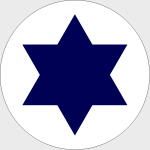Corgi AA99151 Israeli Defense Force De Havilland Mosquito PR.16 and P-51D Mustang - 'Suez Campaign', October 1956 (1:72 Scale)
"Our American friends offer us money, arms, and advice. We take the money, we take the arms, and we decline the advice."
- Moshe Dayan, former Defense Minister of Israel
 The "Mossie," as it was known affectionately by its British crews, was both simple in construction and design. It was a twin engine, single boom aircraft that placed the pilot and navigator in a side-by-side sitting configuration. The Mosquito was one of the most cost effective aircraft ever built because it was constructed out of wood. Balsa was used for the plywood skin, Sitka spruce from Alaska and British Columbia for the wing spars, and Douglas Fir stringers and birch and ash for the longitudinal pieces. These were all held together with glue and wood screws. The result was an airplane that was easy to maintain, tolerant of battle damage, and simple to patch. It was faster than the Spitfire, flew higher than almost any other aircraft, and carried tremendous firepower over great distances. The bomber version operated with relative impunity over Germany til the end of the war, because the Luftwaffe never had a nightfighter fast enough to intercept it. Interestingly, the nightfighter versions of the Mosquito remained in production until 1947, two years after the war in Europe had ended.
The "Mossie," as it was known affectionately by its British crews, was both simple in construction and design. It was a twin engine, single boom aircraft that placed the pilot and navigator in a side-by-side sitting configuration. The Mosquito was one of the most cost effective aircraft ever built because it was constructed out of wood. Balsa was used for the plywood skin, Sitka spruce from Alaska and British Columbia for the wing spars, and Douglas Fir stringers and birch and ash for the longitudinal pieces. These were all held together with glue and wood screws. The result was an airplane that was easy to maintain, tolerant of battle damage, and simple to patch. It was faster than the Spitfire, flew higher than almost any other aircraft, and carried tremendous firepower over great distances. The bomber version operated with relative impunity over Germany til the end of the war, because the Luftwaffe never had a nightfighter fast enough to intercept it. Interestingly, the nightfighter versions of the Mosquito remained in production until 1947, two years after the war in Europe had ended.
No other aircraft of WWII could fly as high, go as far, or fight as hard as the famed Mustang. Piloted by a record 281 Aces, this agile and ferocious dogfighter tallied more kills than any other Allied airplane. As the bombers of the Eighth Air Force fought their way deep into Hitler's Germany, it was the Mustang that cleared the skies of Luftwaffe fighters. The powerful Rolls-Royce Merlin engine gave the Mustang a speed of 445 mph. Re-styled with an aerodynamic bubble canopy for greater visibility, and outfitted with 6 fast-firing .50 caliber machine guns, the P-51 became the best fighter of the war.
Pictured here is an Israeli Defense Force De Havilland Mosquito PR.16 and a North American P-51D Mustang, both of which served in the 'Suez Campaign', during October 1956.
Sold Out!
Dimensions:
P-51D Mustang
Wingspan: 6-1/4-inches
Length: 5-1/4-inches
De Havilland Mosquito
Wingspan: 9-inches
Length: 6-3/4-inches
Release Date: December 2005
Historical Account: "Operation Kadesh" - The Suez Crisis, also referred to as the Tripartite Aggression, was a military attack on Egypt by Britain, France, and Israel beginning on October 29th, 1956. The attack followed Egypt's decision of July 26th, 1956, to nationalize the Suez Canal, after the withdrawal of an offer by Britain and the United States to fund the building of the Aswan Dam, which was in response to Egypt recognizing the People's Republic of China during the height of tensions between China and Taiwan.
Operation Kadesh received its name from ancient Kadesh, located in the northern Sinai and mentioned several times in the Hebrew Pentateuch. Israeli military planning for this operation in the Sinai hinged on four main military objectives; Sharm el-Sheikh, al-Arish, Abu Uwayulah, and the Gaza Strip. The Egyptian blockade of the Tiran Straits was based at Sharm el-Sheikh and, by capturing the town, Israel would have access to the Red Sea for the first time since 1953, which would allow it to restore the trade benefits of secure passage to the Indian Ocean.
The Gaza Strip was chosen as another military objective because Israel wished to remove the training grounds for Fedayeen groups, and because Israel recognised that Egypt could use the territory as a staging ground for attacks against the advancing Israeli troops. Israel advocated rapid advances, for which a potential Egyptian flanking attack would present even more of a risk. al-Arish and Abu Uwayulah were important hubs for soldiers, equipment, and centres of command and control of the Egyptian Army in the Sinai. Capturing them would deal a deathblow to the Egyptian's strategic operation in the entire Peninsula. The capture of these four objectives were hoped to be the means by which the entire Egyptian Army would rout and fall back into Egypt proper, which British and French forces would then be able to push up against an Israeli advance, and crush in a decisive encounter.
On the first day of the conflict, because Israel's intelligence service expected Jordan to enter the war on Egypt's side, soldiers were stationed along the Israeli-Jordanian frontier. The Israel Border Police militarized the Israel-Jordan border, including the Green Line with the West Bank, during the first few hours of the war. This resulted in the killing of 48 Arab civilians by the Israel Border Police, and is known as the Kafr Qasim massacre. This event and the resulting trials of officers had major effects on Israeli law relating to the ethics in war and more subtle effects on the legal status of Arab citizens of Israel.





 Very nice
Very nice 


